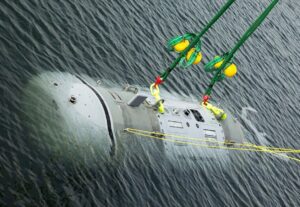The Defense Innovation Unit (DIU) this week published a new solicitation looking for commercial solutions for autonomously navigating Large Diameter Unmanned Underwater Vehicles (LDUUV) to aid the Navy in adding new unmanned forces.
The July 12 notice specifically said it wants to help the Navy find commercial solutions that will allow LDUUVs to autonomously navigate long distances clandestinely with customizable payloads and sensors. It said platforms that provide hardware and software solutions via partnering are also acceptable.

DIU said it will select a solution that incorporates modularity, payload space, open architecture and the ability to work with the Navy’s family of UUV systems. The solution should also have localization sensors, communication capabilities, and software to control the autonomous aspects of the system.
This comes after Naval Sea Systems Command recently issued a sources sought notice for a commercially available LDUUV after Congress allowed the Navy to cancel its Snakehead LDUUV (Defense Daily, July 5).
The FY ‘23 defense authorization bill directed the Navy to perform analysis and experimentation for unmanned operations to identify commercially available LDUUVs that could be deployed as early as FY ‘24.
DIU said the Navy wants to use LDUUVs along these lines to supplement its submarines to perform Preparation of the Environment (IPOE) and Subsea and Seabed Warfare (SSW) mission sets.
The notice said vehicles should be able to be launched and recovered from a surface platform without “considerable platform-specific handling equipment.”
The solicitation said a favorable commercial candidate platform will include characteristics like the ability to navigate in a GPS-denied environment, able to operate at a minimum of 2,500 meter depth and over 200 nautical miles in open ocean transit, able to operate at a minimum two knot heading on current, complete transits under its own power, and demonstrate a navigational error of under 0.1 percent of distance traveled.
It also described the payload space, weight and power reservation minimums the Navy is looking for on the LDUUV: a minimum two meters cubed of payload capacity; at least a 300 pound dry payload mass that is neutrally buoyant; accommodate using both topside and underside deployed payloads, but not necessarily at the same time; the ability to supply up to 400 watts of continuous power to a payload and be interoperable with government furnished software.
The government is seeking an LDUUV with autonomous behaviors including obstacle avoidance, waypoint navigation, and surface and subsurface loitering/station keeping.
DIU plans to host in-person Phase II evaluations at Naval Undersea Warfare Center (NUWC) Division Newport, R.I. The participants chosen for Phase II “will be expected to showcase and prove their proposed solutions capabilities and attributes in water testing locations within approximately three weeks of this [Area Of Interest] closure.”
Responses are due by July 28.
DIU said while it understands companies will not likely be able to meet all the specifications in the solicitation it encourages “companies with demonstrable capability applicable to one or more of these specifications to apply. If vendors are able to outperform the minimal desired characteristics of this AOI (Area of Interest) they will be given priority.”
The government said it will give preference to vendors or vendor teams that show a capability for generating an end-to-end solution and can provide data demonstrating capability in relevant/representative environments.
DIU also said that any prototype Other Transaction Agreement awarded in response to this notice may lead to follow-on production contracts without competitive procedures.